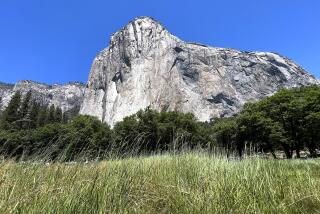Paying for the Parks
- Share via
The American family visiting the Grand Canyon or Yellowstone may be surprised when the ranger at the entrance station asks for only $2 for admis-sion to a magical natural wonderland. The fee covers a week’s stay. Where can you find a bargain like that? Even so, there is considerable sentiment in Congress, and some philosophical justification, for park access to be free. The last fee increase of any kind was in 1972, and all fees have been frozen since 1979.
But the time has come for Congress to consider a new fee schedule for the 48 national parks, 78 national recreation areas and other units where Americans can enjoy the priceless experiences offered by their natural and historic heritage. As Secretary of Interior Donald P. Hodel notes, a family spends more on one round of ice-cream cones than it does to gain entry to Yosemite National Park for a multiday stay.
This does not mean that the national government should begin to look on fees as a primary source for supporting the parks. The parks belong to all Americans for all generations, and Congress has an obligation to see that the parks are operated and maintained out of general revenues to the greatest extent possible.
Recent Administrations and Congresses have been stingy with park budgets. If there is to be any substantial improvement in the parks and their protection, more money is needed. A fee increase is part of the answer.
The Senate Energy and Natural Resources Committee is considering two bills to raise park fees. A Reagan Administration bill would remove current ceilings on entrance fees and set no new limits, although Administration officials have proposed a maximum of $10 per auto. A measure sponsored by Sen. Dave Durenberger (R-Minn.) would set a limit of $5. A $7.50 compromise seems reasonable for the larger, heavily used parks like Yosemite and Yellowstone. They are in relatively isolated areas, and visitors are prepared to spend money to get to the parks and enjoy them.
Both bills would earmark entrance revenues for park use, but the Administration would give 20% to the Treasury for deficit reduction. The parks should not become a deficit-cutting agency. The new entrance-fee money, all of it, should go for park improvements or parkland purchases--not to help buy MX missiles or pay interest on the debt.
Neither bill addresses the more sensitive subject of campground fees, but the Administration often has talked about increases to make them competitive with private campgrounds in nearby areas. Such levies now range as high as $7 a night in Yosemite. There should be no increase in such fees, with the possible exception of giant camper vans and trailers that receive special services such as sewage disposal. A poor family may be able to afford a onetime entrance fee but not a stiff nightly charge for putting up its tent. The maintenance of a nominal and reasonable camping charge is essential to the concept of a park system truly accessible for all to enjoy.
More to Read
Sign up for The Wild
We’ll help you find the best places to hike, bike and run, as well as the perfect silent spots for meditation and yoga.
You may occasionally receive promotional content from the Los Angeles Times.






